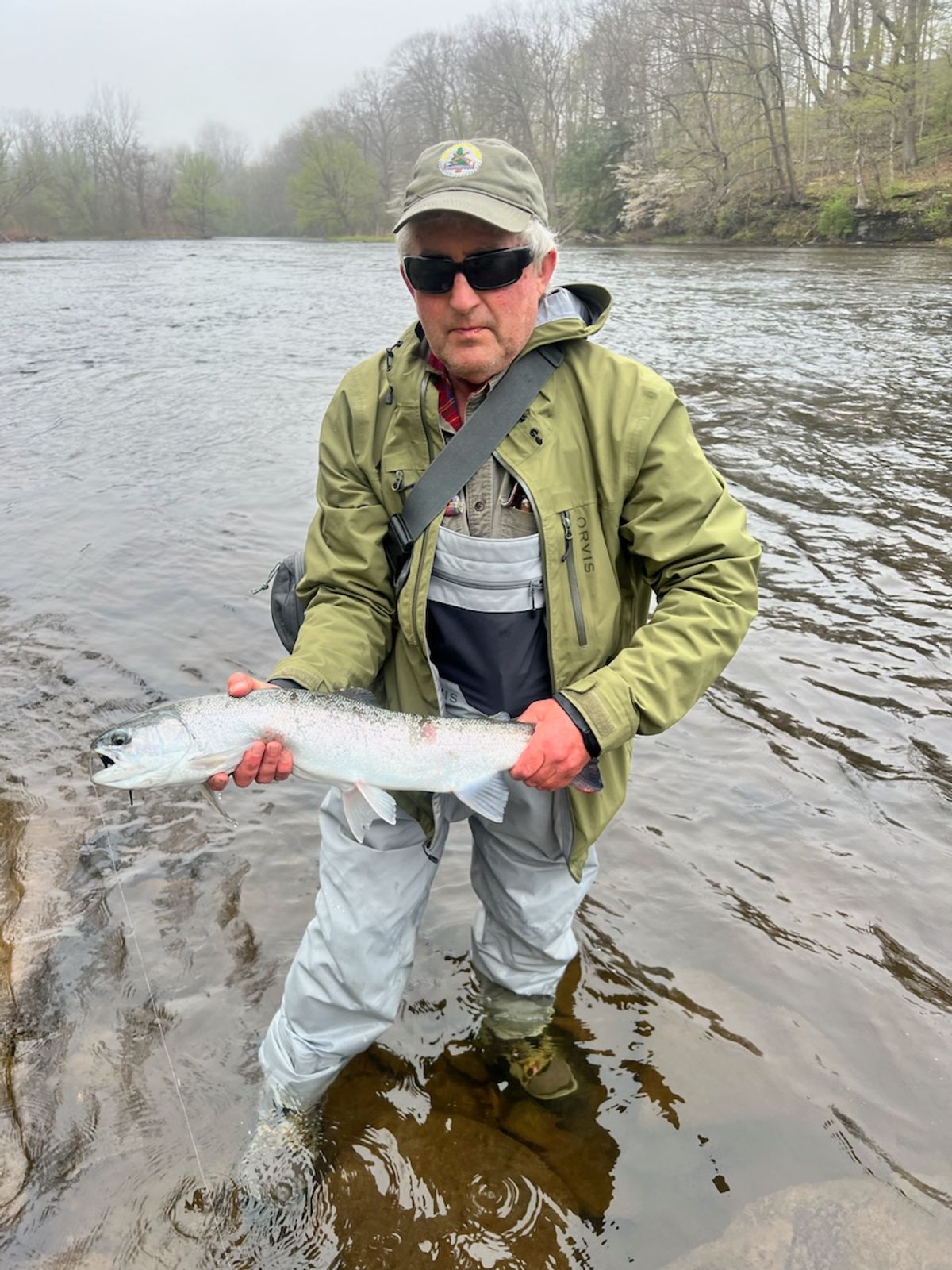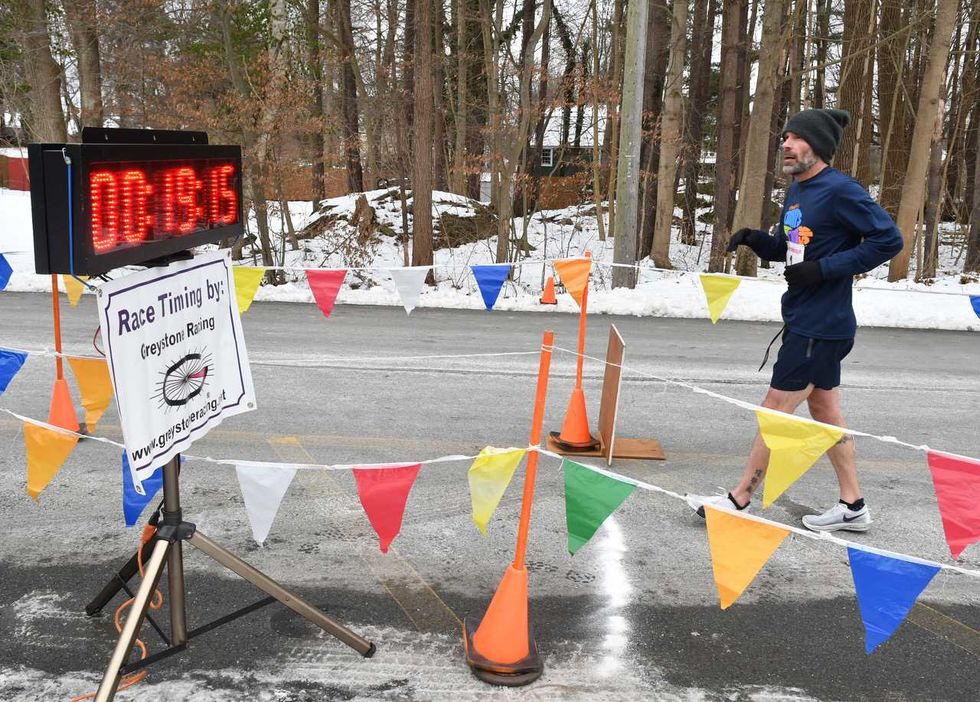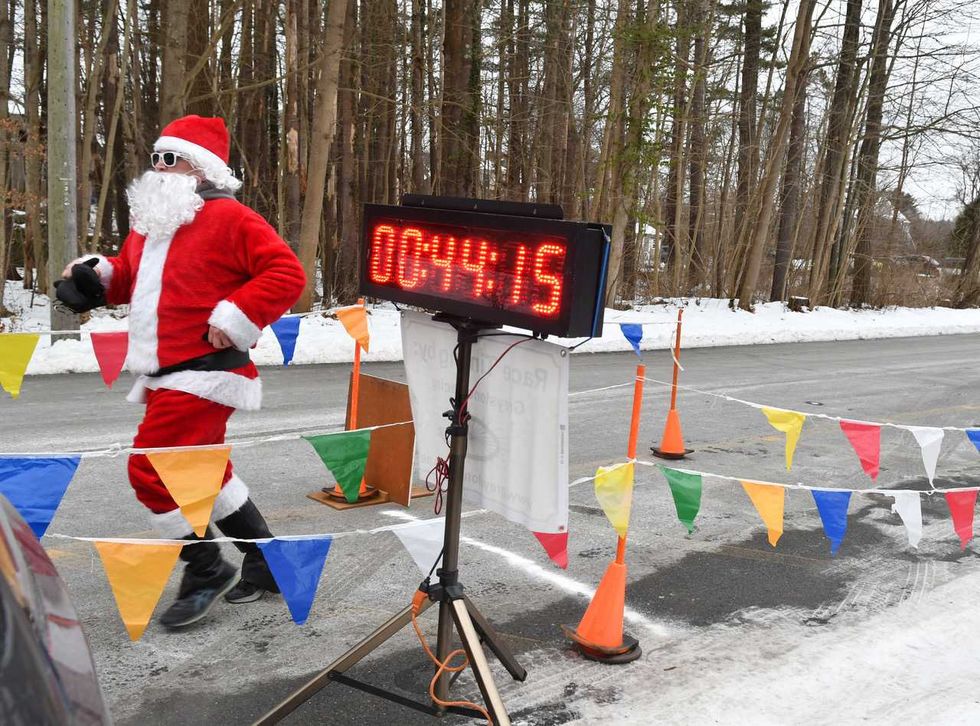Lost in the mail: Tackling the big questions

A steelhead, one could argue, is a rainbow trout on steroids.
Gary Dodson

A steelhead, one could argue, is a rainbow trout on steroids.
Let us open the Tangled Lines mailbag and see what the populi is voxing about.
Agnes Day of Spore City, Ohio writes:
You keep talking about wet flies. Aren’t all flies wet once you cast them into the water?
I could go into a detailed explanation of how the wet fly imitates a transitional stage in an aquatic insects life cycle but I won’t, because this is a family newspaper.
I will offer this anecdote:
I was about 14 and fishing Woodland Valley Creek, a tributary of the Esopus in the Catskills. Dries only. I was having some success but occasionally my fly got waterlogged and provoked strikes, especially when I was trying to retrieve it when it was submerged downstream.
I was working a pool right by a cabin. The building was so close to the stream you could fish from the porch. As I puzzled over how to get that fish that was hanging out by the lower part of the pool, the old-timer on the porch was watching me. I didn’t realize it.
He scared me out of a year’s growth when he spoke up. He asked what fly I was using. “Royal Coachman,” I said. He asked if I had a wet version. I replied, Agnes-like, “A what?”
He came off the porch and made his way to where I was perched at the top of the pool. He borrowed my fingernail clippers and cut off most of the hackle on the Royal and left the white wing.
Then he advised adding a couple of feet of finer tippet, waiting 10 minutes for things to settle down, and flopping the thing into the current, allowing it to swing through the tail out.
I did this and after a couple of false starts caught the fish that had been tormenting me.
Afterwards the old-timer said I should try fishing wet flies upstream just like dries. When I objected that I wouldn’t be able to see the fly he said “Yeah but they’ll see it, and if they see it they’ll let you know soon enough.”
Fester Karbunkle of Potzrebie, New Jersey wants to know:
Do you ice fish?
No I do not. Ice fishing involves walking gingerly out on a frozen pond or lake, cutting a hole in the ice, and staring at it for indefinite periods of time.
I want no part of it. Especially the cutting the ice part. The ice is all that is between me and a cold, watery grave AND WOULD YOU PLEASE STOP CUTTING THE %$@# ICE!
Linus J. Scrimshaw of West Cornwall inquires:
What was your best trout in 2024?
This was a difficult year, with way too much rain at some points and none to speak of at others.
So the most satisfying catch was on the East Branch of the Delaware around Margaretville, New York. The stream was very low and I had to hoof it a couple hundred yards through inhospitable terrain until I found a pool deep enough to justify the term.
I could see the trout, and they could see me. So it just turned into a grim battle. Who would give up first?
After considerable time, and several “look but don’t eat” moments, I finally got a fat brown on a Bread and Butter nymph fished naked and alone. (The fly, that is. Not me.)
Then I had to go a couple hundred yards through inhospitable terrain back to where I started. My buddy Gary had wisely stayed put and was yanking a fish in when I fetched up. His fish was better than mine.
Honolulu Jones of East Drizzle, Wyoming objects:
Wait a minute. Didn’t you catch a steelhead back in April?
Yes, and you could argue that a steelhead is a rainbow trout on steroids.
But that trip to Pulaski and the Salmon River was so completely out of the usual run of events that I think of it the way other people think of significant milestones, like marriage, or the first arrest.
I forgot half my gear, sprained my wrist turning the knob in the shower, and almost lost an earlobe when a gust of wind blew a size 4 black Wooly Bugger (with rubber legs) back into my personal face.
And after fruitlessly flogging the water for two days, I absently flipped the Bugger into a deep hole, just trying to get some line out, when the steelie loomed up and chowed down.
So no, my first and only steelhead wasn’t the best fish of 2024. It was a happy accident and nothing else.
Runners line up at the starting line alongside Santa before the start of the 5th Annual North Canaan Santa Chase 5K on Saturday, Dec. 13.
NORTH CANAAN — Forty-eight runners braved frigid temperatures to participate in the 5th Annual North Canaan Santa Chase 5K Road Race on Saturday, Dec. 13.
Michael Mills, 45, of Goshen, led the pack with a time of 19 minutes, 15-seconds, averaging a 6:12-per-mile pace. Mills won the race for the third time and said he stays in shape by running with his daughter, a freshman at Lakeview High School in Litchfield.

Don Green, 64, of Red Hook, New York, was second among male runners with a time of 21:17 and a 6:52-per-mile pace. Becky Wilkinson, 47, of Southfield, Massachusetts, was the first woman to cross the finish line with a time of 22:16, averaging a 7:11-per-mile pace. Wilkinson finished fourth overall.
Margaret Banker, 52, of Lakeville, finished second among women runners with a time of 23:59 and a 7:44-per-mile pace.
Runners came from all over Connecticut, Massachusetts and New York. One runner listed home as London, England. Many were members of the Run 169 Towns Society, a group that is dedicated to completing races in every one of Connecticut’s 169 towns. Elizabeth Smith, 32, of Manchester, a member of Run 169, said this was her 162nd town.
“I started 10 years ago,” Smith said. Her husband, Daniel, 33, has run races in 73 Connecticut towns, now including North Canaan. He was eager to know where to get a good cup of coffee after the race.
Santa, who got a head start on the group of runners but finished next to last with a time of 44:14, has been a feature in the North Canaan race since it started five years ago.
The 5K proceeds from a start in front of the North Canaan Elementary School on Pease Street to course around the Town Hall parking lot, up West Main Street past the transfer station to the state line and back. Cheryl Ambrosi, 45, of Danbury, was the last to cross the finish line with her dog Benji. “It was so much fun,” she said as she ended, even though she didn’t catch Santa.

The Torrington Transfer Station, where the Northwest Resource Recovery Authority plans to expand operations using a $350,000 state grant.
TORRINGTON — The Northwest Resource Recovery Authority, a public entity formed this year to preserve municipal control over trash and recycling services in northwest Connecticut, has been awarded $350,000 in grant funds to develop and expand its operations.
The funding comes from the Department of Energy and Environmental Protection via its Sustainable Materials Management grant program. It is intended to help the NRRA establish operations at the Torrington Transfer Station as well as support regional education, transportation, hauler registration and partnerships with other authorities.
Founded by the City of Torrington in May 2025, the NRRA was established to oversee regional municipal solid waste management. Its creation followed a $3.25 million offer by USA Waste & Recycling to purchase the Torrington Transfer Station — a sale that would have privatized trash services in the region.
The proposed sale was initially approved by the MIRA Dissolution Authority, the entity responsible for dissolving the state’s former Materials Innovation and Recycling Authority, which owned the Transfer Station at the time. Before the transaction could close, the state intervened and directed that the facility’s operating permit be assigned to the NRRA to preserve a publicly controlled alternative.
MIRA has since dissolved, and the Transfer Station is currently operated by the state Department of Administrative Services. Many towns in northwest Connecticut have expressed interest in joining the NRRA. As of December, Torrington and Goshen were the only two municipalities in the authority.
At the Dec. 11 meeting of the Northwest Hills Council of Governments (COG) — a regional planning body representing 21 municipalities in northwest Connecticut — Director of Community and Economic Development Rista Malanca encouraged more towns to sign on.
“We need towns to join the Northwest Resource Recovery Authority to show your support, show this is what you want to do,” Malanca said.
Salisbury First Selectman Curtis Rand said his municipality is planning a town meeting in January to vote on a resolution to join the NRRA. Cornwall’s Board of Selectmen recently discussed scheduling a town meeting in the winter for the same purpose. Sharon, Falls Village and North Canaan have also expressed continued interest in pursuing a public option.
Kent is the northernmost member of the Housatonic Resource Recovery Authority, a regional solid waste authority representing 14 municipalities stretching south to Ridgefield. COG towns expressed interest in joining HRRA in 2024, but they were denied and set out to develop the NRRA.
“We also have been having conversations with the Capital Region Council of Governments and the Naugatuck Valley Council of Governments to think about how we can use existing resources, maybe some of these grant funds, to bring in shared resources or shared staffing that will help with some of the recycling coordinating efforts,” Malanca said.
With grant funds secured, NRRA aims to grow to a point that it can take over operations at Torrington Transfer Station to serve as a regional hauling hub. What happens to the trash after that has yet to be determined. Currently, it is being shipped to a landfill out of state. The existing municipal refuse hauling contracts that were established with the state expire in 2027.
The Salisbury Winter Sports Association (SWSA) will host its annual Junior Jump Camp, a two-day introduction to ski jumping, on Saturday and Sunday, Dec. 27 and 28, from 9 a.m. to 2 p.m. at Satre Hill in Salisbury.
The camp is open to children ages 7 and up and focuses on teaching the basics of ski jumping, with an emphasis on safety, balance and control, using SWSA’s smallest hill. No prior experience is required.
The cost is $50 per child and includes instruction and lunch on both days. For more information or to register, visit www.skireg.com/swsa-camp or email info@jumpfest.org
Jesse Bunce, first selectman of North Canaan.
LITCHFIELD — The Northwest Hills Council of Governments welcomed six newly elected municipal leaders Thursday, Dec. 11, at its first meeting following the 2025 municipal elections.
The council — a regional planning body representing 21 towns in northwest Connecticut — coordinates transportation, emergency planning, housing, economic development and other shared municipal services.
Barkhamsted First Selectman Meaghan Cook, Goshen First Selectman Seth Breakell, Kent First Selectman Eric Epstein, Norfolk First Selectman Henry Tirrell, North Canaan First Selectman Jesse Bunce and Torrington Mayor Molly Spino were each elected to their post in November.
They filled the seats of their predecessors on the COG, who were each given a toast of appreciation: Nick Lukiwsky (Barkhamsted), Todd Carusillo (Goshen), Marty Lindenmeyer (Kent), Matt Riiska (Norfolk), Brian Ohler (North Canaan) and Elinor Carbone (Torrington).
COG Executive Director Rob Phillips said the outgoing members were given a going away mug that read “You’re living the dream still.” Members voted to appoint Warren First Selectman Greg LaCava to fill a vacancy on the Council’s Executive Committee. COG members voted by paper ballot, and LaCava defeated Burlington First Selectman Doug Thompson for the vacant seat.